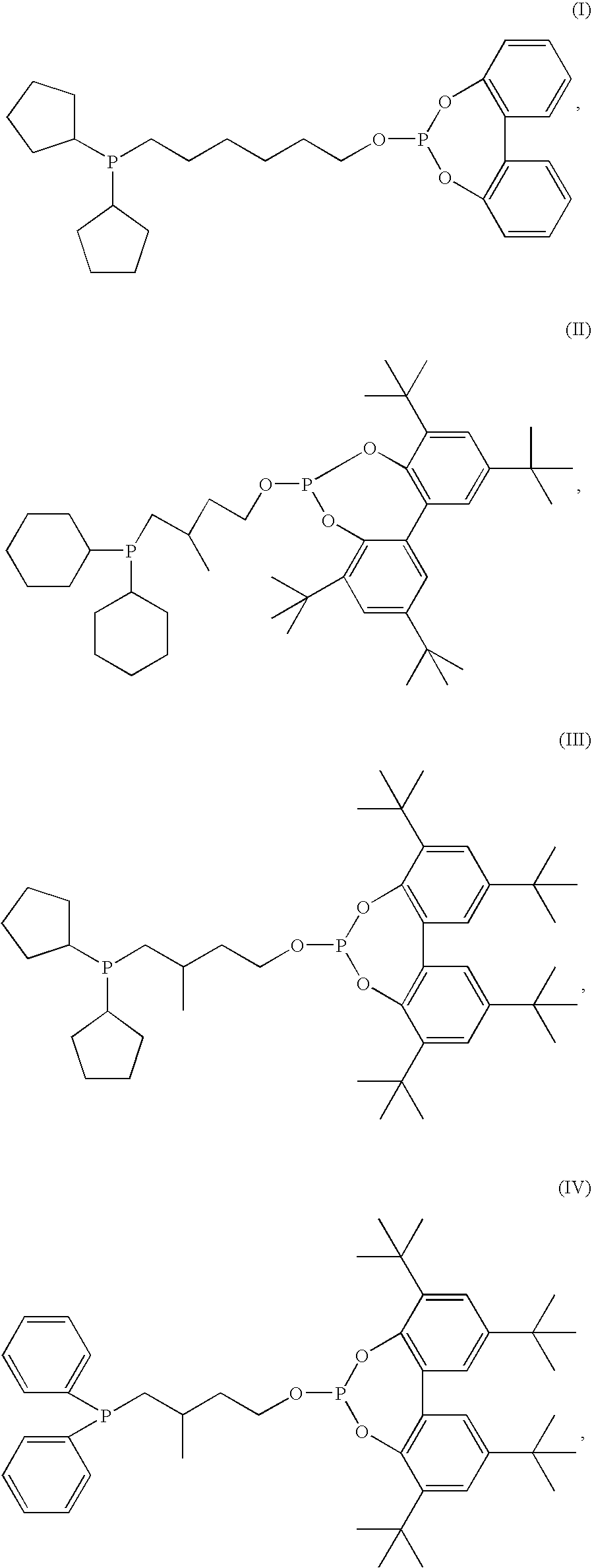Hydroformylation catalysts
a technology of hydroformylation catalysts and catalysts, applied in the direction of organic compounds/hydrides/coordination complex catalysts, physical/chemical process catalysts, organic compounds/hydrides/coordination complexes, etc., can solve the problem of narrow linear to linear production of aldehydes
- Summary
- Abstract
- Description
- Claims
- Application Information
AI Technical Summary
Problems solved by technology
Method used
Image
Examples
example 1
Preparation of Compound (III)
[0039]Dicyclopentylphosphine (5 ml, 27.35 mmoles) was mixed with AIBN (2,2′-azobisisobutyronitrile, 0.6 g) and 3-methyl-3-buten-1-ol (3.53 g, 41 mmoles) under nitrogen and was then heated at 80° C. overnight. Two more portions of 0.5 g of AIBN were added. The mixture was then heated to 120° C. briefly and then cooled to room temperature. The hydroxyphosphine product was then purified by Kugel-Rohr distillation with the product distilling at 120-130° C. / 0.5 mmHg and yielding 4.93 g of yellow oil.
[0040]2,2′,4,4′-tetra-tert-butylbiphenylphosphorchlorodite (5.6 g, 0.012 moles) in 50 ml of toluene was reacted with a solution of the hydroxyphosphine (3 g, 0.012 moles) and triethylamine (5 ml, 0.035 moles) in toluene (30 ml) at 0° C. The mixture was stirred overnight at room temperature. The reaction mixture was then filtered, and the solvent was stripped off with nitrogen flow. The residue was redissolved in toluene and purified by passing it through a short c...
example 2
Preparation of Compound (IX)
[0041]Tetrahydrofuran (100 ml) was added to a 500 ml 3-neck round bottom flask under nitrogen. 16 ml of diphenylphosphine was measured out into a syringe under nitrogen and was then added to the flask. The flask was placed into an ice bath. N-butyl lithium (45 ml) was then added slowly by syringe. The reaction was allowed to stir at ice temperature for 1 hour. An addition funnel containing 10 g of exo-2,3-epoxynorbornane dissolved in 45 ml of THF was added to the flask, and the solution was added dropwise. The reaction solution was allowed to gradually come to room temperature, and then it was stirred overnight. The reaction mixture was worked up by pouring carefully into a nitrogen flushed solution of water and diethyl ether (50:50 mixture, ˜100 ml). The layers are separated in a nitrogen flushed separatory funnel, the water layers washed with ether, the organic layers combined, and then the solvent was stripped off overnight with a nitrogen flow. The pr...
example 3
Preparation of Compound (XIV)
[0043]The procedure listed above for Compound (IX) was used for the preparation of this compound. Tribenzyl phosphine (12.2 g) was reacted with 25 ml (2M) n-butyl lithium and 3.5 ml of cyclopentene oxide in THF to give 15.1 g of the hydroxyphosphine. The hydroxyphosphine was then reacted with 18.5 g of 2,2′,4,4′-tetra-tert-butylbiphenyl-phosphorchlorodite and 16.4 ml of triethylamine to yield 18.46 g of purified product (57.3%). 31P{1H}NMR (ppm): 144.4, −8.7.
PUM
| Property | Measurement | Unit |
|---|---|---|
| molar ratio | aaaaa | aaaaa |
| temperature | aaaaa | aaaaa |
| pressure | aaaaa | aaaaa |
Abstract
Description
Claims
Application Information
 Login to View More
Login to View More - R&D
- Intellectual Property
- Life Sciences
- Materials
- Tech Scout
- Unparalleled Data Quality
- Higher Quality Content
- 60% Fewer Hallucinations
Browse by: Latest US Patents, China's latest patents, Technical Efficacy Thesaurus, Application Domain, Technology Topic, Popular Technical Reports.
© 2025 PatSnap. All rights reserved.Legal|Privacy policy|Modern Slavery Act Transparency Statement|Sitemap|About US| Contact US: help@patsnap.com



